Since the beginning of Covid, we have seen some trends among consumer spending that have been beneficial to the door, window and conservatory industry. As our lives were curtailed in a variety of ways, and without the opportunity to spend on leisure or the High Street, some homeowners found they were saving money. The result was a boom in the home improvements sector as people recognised the benefit of using these savings to add space and value to their homes. Adding a conservatory is a popular way to do this and with this in mind, DGCOS has published a new Installer Guide: Building A Conservatory.
This is a general guidance document for installers to ensure best practice from start to finish, based on the experiences DGCOS has had in dealing with dispute resolutions for their customers over the last decade. It covers everything from defining what a conservatory is, which might sound obvious but actually isn’t always, to excavations, foundations, drainage and building the structure – issues that all installers should consider from the beginning. In all cases installers must satisfy themselves as to the suitability of what they propose to construct, following all of the latest manufacturer’s requirements. The aim of the guide is to help installers be aware of potential areas where issues may arise, in order to construct a quality build that does not require come-backs due to errors in any part of the planning or building process. In this way, a quality build equals happy customers, boosting reputations and leading to more recommendations. It also supports our aim of ensuring all DGCOS members have access to support and documentation that raises standards in our industry. We hope that this information will help installers avoid some of the pitfalls we have seen from the industry.
What is a conservatory?
While it may at first glance be obvious what constitutes a conservatory, the DGCOS Installer Guide starts by giving a clear definition. It specifies official rules laid out by Local Authority Building Control (LABC) which represents all local authority building control in England and Wales. It is important to check these rules as conservatories as defined by the LABC are exempt from building regulations; anything that falls outside the rules will not be. This has particular relevance if an installer has built something that is not exempt and then ceases to trade, as the cost of retrospectively fixing any problems can be expensive.
Support from start to finish
The guide goes on to explain best practice in terms of assessing a potential site before starting any groundworks to ensure foundations will be the correct depth; the strata the builder is likely to encounter; and whether there are any trees or drains in the area which may be an issue. There is a section on excavations giving advice on how to deal with different soil types – anyone building on clay for example, knows how important that is - plus other things to look out for such as circumstances under which a structural engineer should be engaged. Getting the foundations right is obviously key and there is a section dedicated to this too. The report also deals with the substructure, addressing topics such as damp proofing, and building the superstructure itself. The final section addresses drainage in relation to roof run-off, gutters, outlet pipes and soakaways.
The guide is an invaluable start for anyone involved in building conservatories, but there are also useful links to external bodies that can provide further detailed information such as the Government website for information about the Party Wall Act 1996 and Approved Document A, Citizens Advice for guidance on drains and sewers and links to local authority building control departments. There is support within the support!
Conservatories are here to stay
It remains to be seen what the impact will be of the Mini Budget announced by the Chancellor recently, but ONS Family Spending reports higher income groups could be less negatively impacted by the increasing cost of living rise in interest rates if they have fixed rate mortgages, meaning disposable income could be under less pressure in this instance.
Even among middle income groups, spend on home improvements has been strong over the last few years and whatever the economic forecasts for the next twelve months, conservatories are an integral part of the home improvements sector. They are here to stay and I would urge any installer involved in their installation to download our DGCOS Installer Guide: Building a conservatory.
A copy of the DGCOS Installer Guide: Building a conservatory can be viewed here
